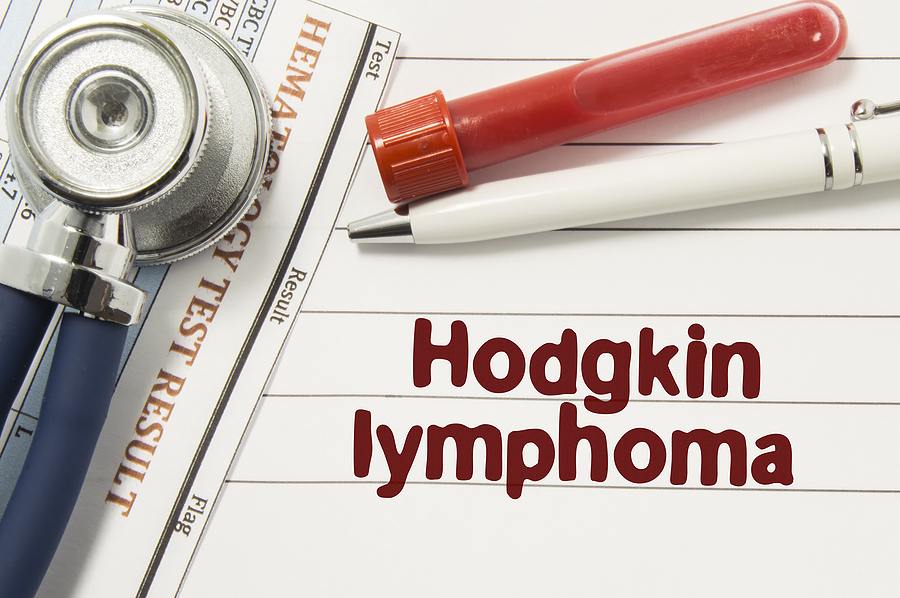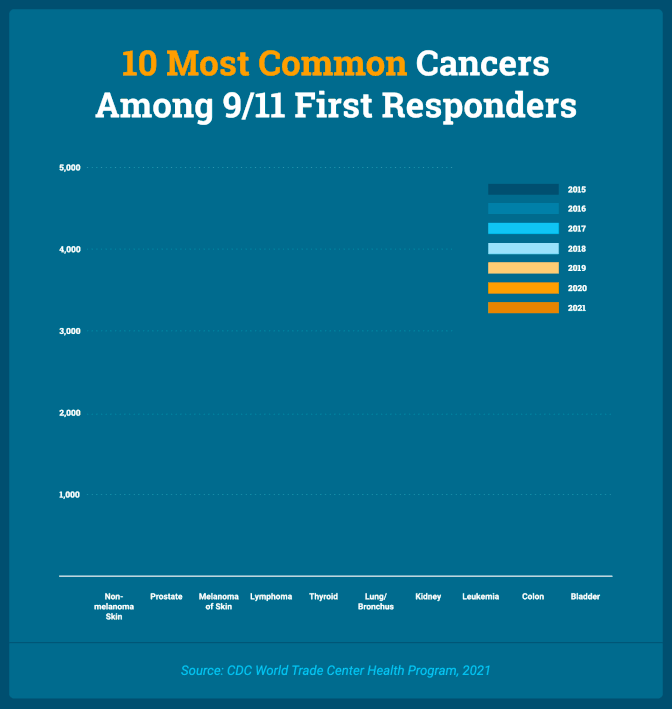How Does 9/11 Cause Hodgkin’s Lymphoma?

Hodgkin’s lymphoma, can be caused by 9/11 toxins. Hodgkin’s lymphoma is a form of lymph cancer that results from a change to the DNA of a lymphocyte, a type of white blood cell. It is one of the covered blood cancers eligible for certification from the WTC Health Program.
Once known as Hodgkin’s disease (named after Dr. Thomas Hodgkin who first described the condition in 1832), it causes a host of immune system-related symptoms. Exposure to the dust cloud after 9/11, including exposure caused by volunteering at Ground Zero or living or working in Lower Manhattan on and in the months after the attacks, can increase your risk of developing Hodgkin’s Lymphoma. This cancer of the immune system can compromise the victim’s overall health and lead to the need for extensive medical treatment—and if you were in the exposure zone, a 9/11 lawyer can help you receive benefits to help pay for it.
Both the lawyer’s services and the benefits are free.
Common Symptoms of Hodgkin’s Lymphoma
Hodgkin’s Lymphoma attacks the immune system. It causes a variety of symptoms, often beginning with swelling of the lymph nodes or night sweats. Many patients write off these symptoms at first, not realizing that they could represent a much more serious condition. It may also cause persistent fatigue and fever, especially as it progresses.
Many patients assume that the fatigue and fever come from a bacterial or viral infection. Persistent symptoms, however, should always receive evaluation and treatment from a doctor.
As Hodgkin’s Lymphoma progresses, patients may also notice unexplained weight loss, even without diet or exercise. Patients may also suffer pain in the lymph nodes when drinking alcohol, or may notice increased effects when drinking.
Treatment for Hodgkin’s Lymphoma
Treatment for Hodgkin’s Lymphoma depends on the “Stage “ of the cancer when diagnosed. Identifying Hodgkin’s Lymphoma starts with extensive testing. Your doctor may recommend a blood test, imaging tests like X-rays and CT scans, and potentially removing a lymph node for further testing and examination. This exam will allow your doctor to determine what type of Hodgkin’s Lymphoma you have and what treatment you will need to increase your odds of making a full recovery.
As part of your diagnosis, your doctor will rate your cancer based on stages that define how much of your body the cancer has affected.
- Stage I: The cancer has entered only 1 organ or lymph node
- Stage II: The cancer has entered more than one lymph node, or an organ and the surrounding lymph nodes, but remains limited to a specific area of the body
- Stage III: You have cancer cells in lymph nodes both above and below the diaphragm, no longer limited to a single area of the body
- Stage IV: The cancer has moved from the lymph nodes and a few organs to your blood, tissue, and bones.
Treatment may include:
Chemotherapy
Chemotherapy delivers powerful chemicals designed to target fast-growing cells within your body. Typically, cancer cells reproduce at a faster rate than other cells. As a result, chemotherapy can kill them while leaving your other cells intact, helping to eradicate cancer cells from your body. Depending on the severity of your cancer, you may take chemotherapy in pill form or via a vein. In some cases, you may use both forms of chemotherapy.
Chemotherapy offers a highly effective way to treat Hodgkin’s Lymphoma, whether you receive chemotherapy during the early stages of the disease or seek treatment as the cancer progresses.
However, it may cause a host of side effects, including:
- Nausea, diarrhea, and vomiting
- Fatigue
- Loss of appetite
- Hair loss
- Pain
- Constipation
- Mouth sores
- Easy bleeding
- Increased risk of infection
Patients pursuing chemotherapy treatments for Hodgkin’s Lymphoma should listen to their doctor about their limitations. Some patients may need to avoid working while undergoing chemotherapy treatments. Others may need to decrease overall public exposure.
Radiation
During radiation therapy, machines deliver high doses of radiation directly to the cancerous areas on your body. Most often, doctors use radiation during the early stages of Hodgkin’s Lymphoma, when it impacts only a single area of the body. As it spreads throughout the body, your doctor may no longer have the ability to target radiation therapy directly to the cancer.
Radiation, like chemotherapy, brings with it potential side effects. The type of side effects you face may depend on the area targeted by radiation therapy. Many people experience nausea, vomiting, and fatigue, regardless of where the radiation occurs. They may also suffer from mouth sores or skin changes. You should consult your doctor to learn more about the potential side effects of your radiation treatment.
Like chemotherapy, radiation treatments may prevent patients with Hodgkin’s Lymphoma from returning to their usual work duties. Some people can continue working as usual while undergoing radiation treatment. Others may need to take time off work or drop to a part-time schedule to account for changes in energy level and overall health. Ask your doctor what steps you need to take to protect your overall health if you need radiation to treat your cancer.
What Should You Do if You Face a Hodgkin’s Lymphoma Diagnosis Because of Your Exposure to the 9/11 Dust Cloud or Toxins?
The attacks on the Twin Towers resulted in an immense cloud of dust and debris rising into the air. This cloud and other toxins filled Lower Manhattan in the months following 9/11. Many people faced exposure to the dust cloud: not only those who volunteered or worked at Ground Zero, who would have experienced direct exposure during their efforts to recover victims, but workers who helped remove the debris following the attacks and those who lived, worked, and went to school in the area in the months following the attacks.
If you see any sign of Hodgkin’s Lymphoma or another illness, you should quickly take steps to seek treatment and protect yourself both physically and financially.
Step One: Seek Medical Attention
If you faced any exposure to the dust cloud after 9/11, whether direct or indirect, then you may already know that you have an increased risk of developing Hodgkin’s Lymphoma along with numerous cancers and potential respiratory ailments. As a result, you should remain aware of potential symptoms of developing cancer, including night sweats, ongoing loss of appetite, or fever that does not seem to resolve in a normal time frame.
As soon as you notice those symptoms, seek medical attention. You can choose to:
1) See your doctor. If you already have a doctor who treats you regularly and knows about your medical history, you may want to see your own doctor for the first round of tests. Make sure you let your doctor know about that potential dust cloud exposure, since it may help your doctor pursue an accurate diagnosis.
Let your doctor know about any symptoms you have experienced and anything that feels “off” or “odd,” even if you think it does not pertain to your potential diagnosis. The more information you share with your doctor, the more accurately your doctor can diagnose any problems.
2) Seek care through the WTC Health Program. In addition to providing treatment for known ailments that occurred as a result of dust cloud exposure after 9/11, the WTC Health Program offers screening services to anyone who may have faced dust cloud exposure. That includes individuals who volunteered directly at Ground Zero, those who aided in the cleanup, and those who lived, studied, and worked in Lower Manhattan following 9/11. If you have evidence of your potential exposure in easy reach, you may want to pursue a diagnosis through the WTC Health Program to reduce your medical costs.
2) Develop a Treatment Plan
With any illness, including Hodgkin’s Lymphoma, a comprehensive treatment plan can help you determine what steps you need to take next to maximize your odds of making a full recovery. Let your doctor know about your potential dust cloud exposure and how it may relate to your diagnosis. You may choose to pursue treatment through the WTC Health Program, which provides treatment to victims of the 9/11 attacks free of charge.
The program, however, does use specific clinics and hospitals, many of them in New York and the surrounding area, to provide treatment to victims of the attacks. Some people do choose to pursue treatment from another source, whether because of geographic convenience or due to higher levels of confidence in a specific provider.
A treatment plan can help you get an idea of what treatment for your illness will look like and how long you can expect it to take. You may need to notify your employer about your diagnosis and pending treatment, especially if you will need to take time off work for early procedures and appointments.
You may need to revisit your treatment plan throughout your treatment, especially if your diagnosis changes. You should follow your treatment plan to the best of your ability, even through those changes, to maximize your odds of making a full recovery.
3) Contact an Experienced 9/11 Attorney
Once you have a diagnosis related to your exposure to the dust cloud after 9/11 in hand, you may have the right to file a claim through the VCF. The VCF provides compensation to victims of the 9/11 attacks, including those who may not have realized the severity of the illness or diagnosis they suffered until years later.
If you have eligibility for a VCF claim related to your diagnosis, the experienced 9/11 lawyers at Hansen & Rosasco can help you navigate that claim and maximize the compensation you ultimately receive. A lawyer can:
Help you find evidence of your exposure. To file a VCF claim, you will need to show evidence that you faced exposure to the dust cloud in late 2001 or early 2002. You may need to show that you volunteered to help at Ground Zero, either with immediate rescue efforts or with cleanup, or that you lived or worked in the area immediately after the attacks, which could have led to exposure.
Some people can easily provide those records. They may have copies of school records or rent receipts that show that they lived in the area immediately after the terrorist attacks. Others, however, may need more assistance locating those records, including hunting down information from an employer that may no longer exist or that may not have kept those records. An attorney can help give you a better idea of where to find that information.
Assist in filling out the paperwork for your claim. If you fail to fill out VCF claim paperwork, or you fill it out incorrectly, the VCF may need to postpone processing your claim until you submit additional information. While you can have time to submit that information, it may delay your claim. An attorney can help ensure that you fill it out correctly the first time.
Provide information about the compensation you deserve. Many victims of the 9/11 attacks, especially those that have to face a diagnosis years after the attacks, may not know how much compensation they really deserve. An attorney can help break down the compensation offered by the VCF and how to maximize it.
Contact a 9/11 Attorney Today
If you have received a Hodgkin’s Lymphoma diagnosis due to exposure to the dust cloud after 9/11, an attorney can help you seek the compensation you deserve through the VCF. Contact an experienced 9/11 attorney today to learn more about your rights.

